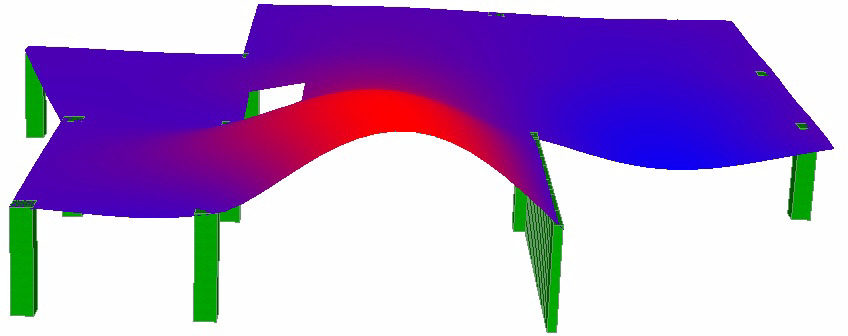Free Vibration
Free vibration of undamped structures occurs when the structure is displaced to an initial displacement, released and then allowed to vibrate freely. It is related only to the stiffness and mass in the structure. The preferred vibration patterns of the structure are referred to as the natural modes of vibration. Each mode of vibration has a characteristic deflected shape and an associated vibration frequency. If an undamped structure is initially displaced to a natural mode shape and then released, the structure will undergo simple harmonic motion (displacement vs. time curve has a sinusoidal shape). The mode shape with the lowest natural frequency is referred to as the fundamental mode of vibration.
Floor structures may have many very closely spaced natural modes of vibration, with only small parts of the structure participating in each one. To capture the complete dynamic response, it is necessary to calculate enough modes to include all modes with natural frequencies of interest, which generally include modes with frequencies up to about 12-15 Hz for resonant response analysis and up to about 2 times the fundamental mode of vibration for impulsive response.
The following options in the Vibrations tab of the Criteria – Calc Options dialog affect the vibration calculations:
Number of modes
RAM Concept allows the user to input the number of mode shapes to be calculated. The frequencies of the mode shapes can be viewed in the text tables and the number of mode shapes calculated increased as necessary.
Dynamic concrete modulus factor
RAM Concept allows input of a dynamic concrete modulus factor which represents the ratio of dynamic modulus to the static modulus. The dynamic modulus of elasticity of concrete (small strains for short durations) is generally higher than the static modulus of elasticity. The dynamic modulus affects the stiffness of the structure and thus factors into the calculation of the natural frequencies and mode shapes. The default factor in RAM Concept is 1.2.
Stiffness matrix
RAM Concept also allows selection of the stiffness matrix to use in the calculation of frequencies and mode shapes. If one of the load history stiffness matrices is used (for example to account for cracking), the load history analysis must be run after selecting the load history step to use for stiffness matrix and prior to the vibration calculations.
In RAM Concept , the structure self-mass is always considered automatically in the analysis, which can be adjusted by setting the "Density for Loads" property in the concrete material properties. In some cases there is additional mass permanently in place that should be considered in the analysis of the frequencies and mode shapes. This additional mass can be drawn on the additional mass layer located under the Vibrations folder. This layer allows the user to define area loads, line loads, and point loads that will be converted to mass for vibration analysis purposes.

